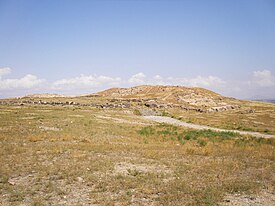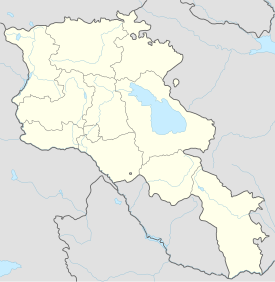Teishebaini

Karmir Blur "Red Hill"
|
|
| Alternate name | Karmir Blur |
|---|---|
| Location |
Yerevan, Armenia |
| Coordinates | 40°09′14″N 44°27′12″E / 40.153888°N 44.453366°E |
| Type | city, palace, and citadel |
| Area | 44.5 ha (110 acres) |
| Height | 901 metres (2,955 ft) |
| History | |
| Builder | Rusa II |
| Founded | Between 650 and 600 BC |
| Abandoned | 585 BC |
| Site notes | |
| Excavation dates | 1939-? |
| Condition | Ruins (portions of walls remain) |
| Public access | Yes |
| Website | Erebuni Historical & Archaeological Reserve: Teishebaini Citadel |
Teishebaini (also Teshebani, modern Karmir Blur (Armenian: Կարմիր Բլուր) referring more to the hill that the fortress is located upon) was the capital of the Transcaucasian provinces of the ancient kingdom of Urartu. It is located near the modern city of Yerevan in Armenia. The site was once a fortress and governmental centre with towered and buttressed perimeter walls, massive gates, a parade ground within its walls, and storage rooms that entirely occupied the ground floor. The site of the city, palace and citadel together measure over 0.45 km2 (110 acres). The name Karmir Blur translates to "Red Hill" because of the hill's reddish hue. It became this color after the city was set on fire and the upper walls which were made of tuff fell and crumbled because of the heat. After the tuff was heated by the fire, it took on a more intense red color and therefore the hill became red. The lower portions of the walls were left standing after the fire since they were built with a stronger stone. Teishebaini is situated at a height of 901 metres (2,956 ft).
The city of Teishebaini was built by Rusa II in mid-7th century BC to protect the eastern borders of Urartu from the barbaric Cimmerians and Scythians. Within the city was a governors palace that contained a hundred and twenty rooms spreading across more than 40,000 m2 (10 acres), and citadel named the Citadel of Teisheba after the Urartian god of war. The palace was made of stone, with timber ceilings, and timber columns that supported the roof. The construction of the city, palace, and the citadel were not fully finished until the reign of Rusa III, some 50 years later.
Agriculture was essential to the city, as was raising livestock. The Urartians built massive water canals, some of which are still in use to this day. Archaeological excavations have shown that lentils, hemp, peas, sesame, wheat, and barley were some of the grains that were grown in the area, as well as grapes and plums. The grape seeds that had been found were examined further and it revealed that twelve varieties of grape were grown in the surrounding area of Teishebaini during this time. All of these ancient varieties and more are still grown to this day in modern Armenia. Smaller ceramic vessels were also found in excavations and are known to have been used in brewing beer made from barley. Other much larger vessels were used for storing foods and wine. Small circular markings on the sides of the containers near the top indicated the amount that could be stored inside. The vessels were usually buried half-way into the soil which naturally kept foods cool.
...
Wikipedia

